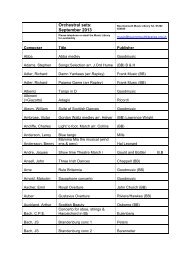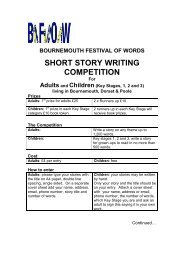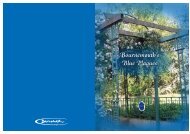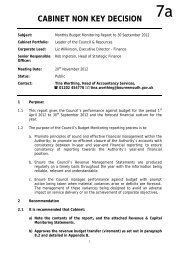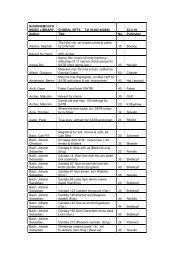Holdenhurst Village Conservation Area Appraisal - Bournemouth ...
Holdenhurst Village Conservation Area Appraisal - Bournemouth ...
Holdenhurst Village Conservation Area Appraisal - Bournemouth ...
Create successful ePaper yourself
Turn your PDF publications into a flip-book with our unique Google optimized e-Paper software.
Twentieth Century - 1900s<br />
7.9 Whilst some European architects were<br />
experimenting with new materials<br />
and construction techniques, in the<br />
early part of the twentieth century<br />
Britain’s domestic architecture was<br />
influenced by a more backwards looking<br />
architectural tradition. Cottages,<br />
such as South Lodge (early 1920s),<br />
are reflective of the Arts and Craft<br />
movement, a style that reflects earlier<br />
vernacular traditions, utilising features<br />
such as heavy chimney stacks and<br />
sweeping catslide roofs.<br />
7.10 The interwar period (1920s and 1930s)<br />
was also influenced by the Art Deco<br />
style of the Modern Movement. This<br />
architecture with its bold shapes and<br />
smooth surfaces was usually associated<br />
with the leisure and entertainment<br />
industry. However, it did filter down to<br />
influence the design of more modest<br />
buildings including domestic dwellings.<br />
The <strong>Village</strong> Hall in <strong>Holdenhurst</strong> dates<br />
from this period.<br />
7.11 In the immediate post second<br />
world war period there was a great<br />
demand for new dwellings and a<br />
focus was placed on fast construction<br />
techniques that could mass produce<br />
housing quickly with less emphasis on<br />
architecture detailing. A shift from<br />
private individuals towards mass<br />
produced local authority housing was<br />
also seen at this time. Properties of<br />
this period such as Nos. 24 and 25<br />
<strong>Holdenhurst</strong> <strong>Village</strong> reflect the slightly<br />
plainer architecture detailing of the<br />
post war period.<br />
7.12 In more recent years architecture in<br />
the village has tended to reflect earlier<br />
styles but in a less exuberant way. For<br />
example, Bramleys (to the Manor Farm<br />
development) utilises a mix of past<br />
styles and materials associated with<br />
older dwellings (i.e. thatch) to add<br />
interest to the building.<br />
Local Qualities<br />
7.13 <strong>Holdenhurst</strong> contains a number of<br />
buildings of architectural merit (both<br />
listed and unlisted). These buildings<br />
contain a mixed palette of traditional<br />
materials including several examples of<br />
thatch roofing. As well as the materials<br />
used, the architectural detailing (for<br />
example the fine decorated windows to<br />
the church and the use of decorative<br />
door porches to dwellings) all adds<br />
visual interest contributing a richness<br />
to the character of <strong>Holdenhurst</strong>.<br />
Roof Coverings<br />
7.14 Dorset thatch has a style that is distinct<br />
from that of many other counties.<br />
A lot like Hampshire thatch roofing,<br />
typically Dorset thatch is very plain<br />
with little or no ornamentation to the<br />
ridge (as illustrated by Holly Hurst,<br />
No. 20 <strong>Holdenhurst</strong> <strong>Village</strong>; No. 17<br />
<strong>Holdenhurst</strong> <strong>Village</strong>; and Magdalen<br />
Cottage, No. 1 <strong>Holdenhurst</strong> <strong>Village</strong>).<br />
The normal practice of thatching in<br />
Dorset is to re-coat the roof, this<br />
means that many historic properties<br />
have an important series of layers of<br />
thatched material.<br />
Thatch Roof of Holly Hurst, No. 20<br />
<strong>Holdenhurst</strong> <strong>Village</strong><br />
<strong>Holdenhurst</strong> <strong>Village</strong> <strong>Conservation</strong> <strong>Area</strong> <strong>Appraisal</strong> - March 2014 33



